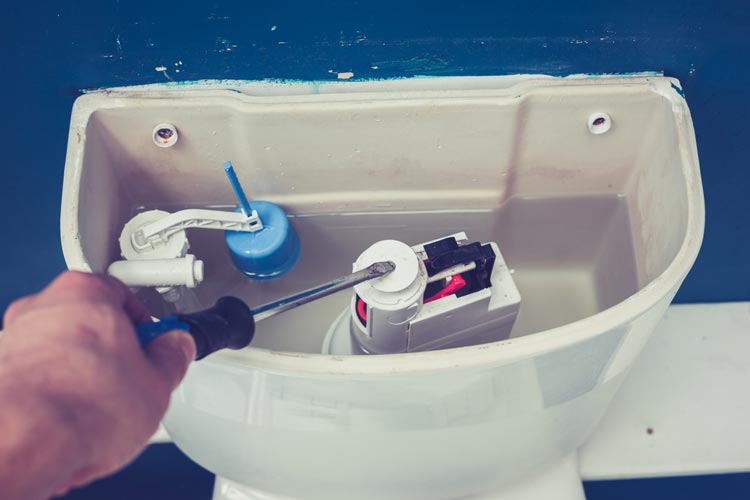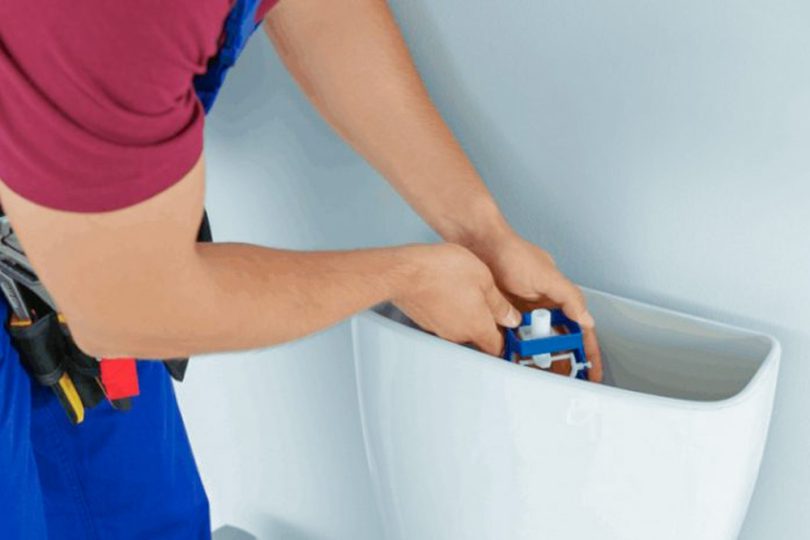Slowly filling single or dual flush toilets are a prevalent problem in the modern household. With the right amount of water, the average time for the tank to refill is about three minutes. If your toilet tank takes more than three minutes, then you might have a problem.
A lot of factors disrupt the pressure of water coming into the container, from debris issues to the age of the valve.
Over time, fragments of debris build up in the water system consisting of the valve body, the supply line, and the shut-off valve, to create a clog which causes the drop in pressure and in the long run increases the time it takes to for the tank to be full.
The average life span of a shower valve is seven years. So before you try to fix any issue, remember the date you installed the shower valve.
If you are facing a slow toilet issue, this guide will teach you how to identify the issue and how to fix a slow filling toilet tank. Let’s get started right away.
Troubleshooting a Slow Running Toilet
As earlier stated, it can be frustrating to have this problem with your top-class fill valve, so here are the easiest do- it- your -self method to get your toilet tank filling fast.
1. Partially open valve
this is the most common reason why people have slowly running toilet tank. Sometimes the water supply valve under the container might be partially open, check if it is fully accessible. If it is not, open it fully to let water flow freely into the tank.
2. Tube clogs
another reason why the toilet tank might be filling to slowly is when there is clogging in the valve caused by a buildup of debris.
Fixing this problem is easy. Put off the valve by the wall shutting the water off. Take away the hardware from the valve and use a bottle brush or a slim and robust wire to break the clog in the tube.
Then place a cup above the pipe and at intervals put off and put on the valves to be sure the valve is clogged free. Pace the hardware back, and you should have your problem solved
3. Faint water pressure
the final easily repaired reason is due to weak water pressure. All you have to do in this case is to install a booster tank which should help increase the water pressure.
If you use a well, all you have to do is to turn the water up at the well’s tank, if you continue to have the same problem you might want to get a new pump or tank when necessary.
These tips can go a long way to fix a slow running toilet.
How to Fix a Slow Filling Toilet Tank: DIY Guide

This issue is problematic, and all of those troubleshooting tips listed above can fail. Do not worry. You do not have to get a new house or completely change the entire toilet.
You don’t have to call the plumber if you have the necessary will power and the right repair kit.
You can fix it yourself. And with the steps below, your toilet tank is going to be working up to full potential.
Float Ball Needs to Be Readjusted:
**Float Ball adjustment guideline
Most experienced plumbers discover that the float bail can be the most rampant reason why the toilet tank fills slowly. The float bail sits on top of the liquid in the reservoir. It dictates the amount of water coming into the tank, by using an arm attached to it to stop any further water entry.
Sometimes the float bail is fixed too low, which makes the water entering the tank to be inadequate. All you have to do to repair this issue is to bend your float arm slightly upward, so the bail comes higher to stop the water flow later.
If this tip doesn’t adequately correct your toilet issue. And you notice that the float bail remains low. In this case, you might need to change the bail completely.
How to Adjust a Fill Valve?
**Fill valve adjustment guideline
If you notice that your problem is still not solved after adjusting your float ball. The problem might be coming from your fill valve. Your fill valves in toilets manage water flow coming into the tank from the source tank to fill the reservoir.
Some toilet fill valves make use of the float arms, the best way to fix the problem in this instance is to remove the tank cap and find your fill valve, they are usually placed on your left side.
Use the flat-headed screwdriver to get into that adjustment screw and in a clockwise screw raise the fill valve to let more water into the tank, you can also lower your fill valve by moving your screw anti-clockwise, lowering your fill valve for less water.
Now flush and observe if the reservoir fills appropriately. Check if your tanks cylinders can be adjusted. Then grip the float clip, which is close to your float valve and try to shift it up, which should let more water in.
You can also slide it back down to reduce the water coming into the valve.
Trip Assembly
The trip handle is connected to your flush handle inside your tank. This handle can be poorly positioned for a reason: bad plumbing. It can also block itself if the lid has been put on, this shortens the rinse cycle, as it is not completed correctly.
Now open the lid and observe the trip assembly. If you find any crookedness in the trip assembly, then it is time to replace the trip’s assembly completely.
Low Water Pressure
As earlier stated. This problem does not come from your tank, check the pipes, and replace any old or rusted one. Check for any leaks. They also contribute to dropped water pressure.
When the water pressure in the house drops, all of the appliances in the house can start to malfunction . This problem isn’t rare in older properties
Additional Tips
How to flush sediments and debris from your water supply: it is commonly recommended that you flush and get rid of all the dirt in the water system in order to solve the issue.
Below are the steps to remove the debris from the fill valve;
- Shut down the water supply before you flush the tank.
- Reach for the tank using your right hand to get under the float cup as you pop it up. Using your right hand again grab the gray shaft making sure that the float cup is pushed up. Hold this device steady and do not let the valve shaft to move or the float cup to drop
- Keep your left had on the valve cap then place your free hand thumb where the arm comes out from. Curve the lid and the lever on a counter-clockwise motion to unlock. After doing all these, you will be able to raise the lid and the lever away from the cap body.
- When you remove the lid assembly look for any debris in the seal ( the seal is a rubber disc and a pin protruding of) and also check the valve part that is still left in the reservoir.
- Holding a cup inversely, above the exposed hole of your valve then put on the supply for a steady ten to fifteen seconds, causing the pressure of the water to push any dirt out of the water.
- Restore the valve’s top, making sure that the cap’s arm is placed next to your refill tube. Then you lock it down by pushing it in as you turn it and the arm also clockwise.
Note: the base hand lifts the float container, that lifts the arm below the cap onto. The highest hand grips the cap as the thumb presses the lifted lever arm.
Repairing parts and using a replacement valve: in times when flushing the sediments does not work. Your next option is to repair or even outrightly replacing the valve. Replacement valves are available at various retail outlets nationwide.
Calling the Plumber
If you have reached this stage and the problem still persists, it might be time to call a professional plumbing service to check for the root cause of the problem.
Having excellent plumbing is great. Having a toilet tank that fills slowly definitely comes with a lot of problems; when you need to use the toilet immediately after a fellow family member has finished using the bathroom.
It can be childish to start counting Mississippi-s before you use the restroom. You want to use it immediately and not have to wait for too long so that you do not forget to flush. Which, in turn, reeks the toilet.
Having a slowly filing toilet tanks makes it so much harder to flush. It can happen to both a two piece and one piece toilets. It is in those awkward times that you find the feces you have just flushed staring at you after the weak sound and flow.
We hope that this post has given you enough information on How to fix a slow filling toilet tank. If you follow the instructions carefully, you’ll be able to fix your slow toilet effortlessly.
FAQs
1. How long does it generally take for a toilet tank to fill?
Ans. A toilet tank usually takes about three minutes to fill up depending on the water pressure. Check and confirm the water shut-off is completely open to maintain the maximum water flow.
2. How much water does a toilet tank hold?
Ans. Toilets made before 1982 use 5 to 7 gallons of water each flush. Many of the toilets made from 1982 to 1993 use 3.5 gallons of water when you flush. The most legal amount per flush for the newest units is 1.6 gallons. Some water-efficient models use even less (1.28 gallons per flush or less). The amount of water that a toilet flushes determines its water holding capacity.
3. Is the toilet tank supposed to be full of water?
Ans. Water tanks are supposed to be half full. If the water level inside your bowl looks too high or low, you should empty the tank and adjust the float until it looks right. Seek help from a plumber if the water level is still off after several adjustments.








Leave a Comment